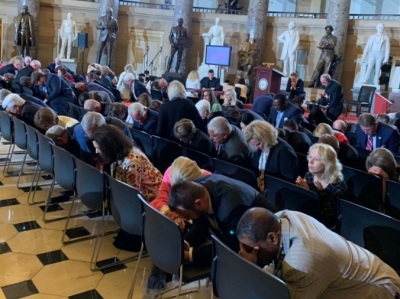National Day of Prayer: How it began early in history

“The government of a country never gets ahead of the religion of a country.”
These were the words of President Calvin Coolidge on October 15, 1924, as he stood at the intersection of Mt. Pleasant and 16th Street in Washington D.C., to dedicate the statue of Methodist circuit preacher Francis Asbury.
Coolidge knew that faith in God and public prayer were among the seeds our Founding Fathers sowed to plant freedom and democracy in America. He knew they would always be vital for its survival and growth.
A century and a half prior, John Hancock helped author the first Continental Congress proclamation for prayer in 1775, calling on the Colonies to observe "a day of publick [sic] humiliation, fasting, and prayer.” Later, then General George Washington echoed that call in 1779.
These and other early leaders knew the true hope of our country was not in politics, but in prayer — not in the power of government, but in the power of God.
This posture of national prayer found early in our history is again echoed in the 2023 National Day of Prayer theme, found in James 5:16: “Therefore confess your sins to each other and pray for each other so that you may be healed. The prayer of a righteous person is powerful and effective” (NIV).
As a nation, we have plenty to confess and much that needs healing, and that journey begins and ends with prayer.
Prayer is more than an individual conversation with God; it is also a corporate act of repentance and renewal. Throughout Scripture, God instructed his people to pray together, and 2 Chronicles 7:14 is arguably the most quoted passage when praying for our nation: “[If] my people, who are called by my name, will humble themselves and pray and seek my face and turn from their wicked ways, then I will hear from Heaven, and I will forgive their sin and will heal their land” (NIV).
But for almost the next 300 years, the people strayed so far from God that they worshiped pagan statues in the Temple, let prostitutes do business in the temple courts, and sacrificed children to idols.
Then King Josiah rose to the throne, and one day he read the law of the Lord for the first time. Overcome, he repented and called for prayer, then read the Word of God to the people, destroyed the idols, ended pagan practices and re-established proper worship.
Today in America, we find a land full of people straying far from God. Church attendance is plummeting and many continue to push for the sacrifice of children to the idol of “my body, my choice.”
History may not repeat itself, but it can echo the past, for evil and good.
On February 7, 1952, at the invitation of then Speaker of the House Sam Rayburn, the Rev. Billy Graham stood on the steps of the U.S. Capitol and preached:
“What a thrilling, glorious thing it would be to see the leaders of our country today kneeling before Almighty God in prayer. What a thrill would sweep this country. What renewed hope and courage would grip the Americans at this hour of peril.”
The next day Congress proposed legislation for an annual National Day of Prayer that was signed into law by President Eisenhower.
“The government of a country never gets ahead of the religion of a country.”
During this year’s National Day of Prayer, remember the words of President Coolidge. Take this opportunity to collectively call on the Lord to hear our prayers, forgive our sins and bring the healing and freedom to our nation that the government cannot.
Timothy Head is the executive director of the Faith and Freedom Coalition.




























